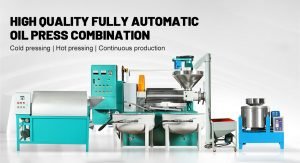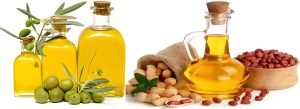Difference between hydraulic oil press and screw oil press
Hydraulic presses apply slow, static high pressure like a giant jack pushing down. Screw presses use continuous, dynamic force with friction and shear inside a barrel, constantly moving material forward.
Let’s break down what these principles mean in practice. Think of a hydraulic press as applying immense weight slowly onto the oilseeds in a fixed chamber. The pressure builds gradually and is held, squeezing the oil out primarily through sheer force over a relatively short distance (the depth of the cake). This is ‘static’ pressure – high force, low movement.
Now, picture a screw press. A rotating screw pushes the oilseeds through a confined space (the press cage or barrel). As the material moves forward, the space typically narrows, and the screw’s design creates intense pressure, friction, and shearing forces. This is ‘dynamic’ pressure – involving continuous movement, friction, and force along a line of contact as material progresses. This fundamental difference is the key. It dictates temperature changes during pressing, suitability for different seeds, wear patterns on machine parts, and the efficiency profile.


Static Pressure: The Hydraulic Way
The hydraulic press exerts pressure vertically, usually from top to bottom, onto a batch of material held within a strong cylinder.
- Pressure Application: Slow, controlled build-up to very high levels (often 60 MPa or more).
- Contact Type: Primarily point or area contact between the ram and the material cake.
- Movement: Minimal material movement once compression starts.
- Heat Generation: Very low heat generated from the process itself (mostly ambient temperature or slightly above).
Dynamic Force: The Screw Press Method
The screw press uses a helical screw rotating within a barred cage or a solid barrel with small openings.
- Pressure Application: Generated by the screw forcing material against resistance and through a narrowing space. Involves friction and shear.
- Contact Type: Continuous line contact along the screw flight and barrel.
- Movement: Constant movement and tumbling of material through the press cage.
- Heat Generation: Significant heat generated due to friction between seeds, screw, and barrel (even in ‘cold press’ screw machines).
Which Press Suits Which Oilseeds Best?
Problem: Using the wrong press for your specific oilseeds? Agitation: Getting poor results, low yield, or even damaging your equipment with certain seeds? Solution: We identify the ideal press type for common and specialty oilseeds.
Hydraulic presses excel with high-value, fragile, heat-sensitive seeds like walnuts or sesame for true cold pressing. Screw presses are the workhorses for high-volume seeds like soybeans, peanuts, and rapeseed requiring throughput.
Matching the press type to the oilseed characteristics is crucial for success. It’s not just about getting oil out; it’s about getting good oil out efficiently and without damaging the equipment or the product.
At Zhengzhou Fude Machinery, our screw presses are engineered for high efficiency and yield, particularly when integrated into a complete line with appropriate pre-treatment like our cookers and roasters. Our hydraulic presses are designed for those prioritizing the absolute highest quality cold-pressed oil from specific seeds.
Hydraulic cold pressing delivers the highest quality oil: minimal heat preserves natural flavor, color, and nutrients. Screw pressing involves friction heat; hot pressing creates roasted flavors but reduces some nutrients, while screw ‘cold’ pressing is warmer than hydraulic.

Hydraulic Press: Simple Use, Specialized Care
- Operation: Generally straightforward. Load the chamber, close it, press a button to start the hydraulic pump, wait, release pressure, open, and unload the cake. The cycle is simple but manual and batch-oriented (unless using very large, expensive automated hydraulic systems, which are rare). Requires operator presence for loading/unloading.
- Maintenance Needs: The main focus is the hydraulic system itself.
- Seals: High pressure demands high-quality seals on the ram/piston. These wear out over time and require replacement. Seal failure leads to leaks and loss of pressure.
- Hydraulic Fluid: Needs to be kept clean (filters changed) and topped up or replaced periodically. Contamination is a major risk.
- Pump & Valves: Require occasional inspection and potential servicing by someone with hydraulic system knowledge.
- Pros: Fewer moving parts in the pressing zone, less daily cleaning complexity within the press chamber itself compared to screw presses.
- Cons: Batch process requires more labor for loading/unloading per ton of material compared to continuous screw presses. Hydraulic system repairs can be specialized and potentially costly if major components fail. Requires a clean operating environment.
Screw Press: Automated Flow, Routine Maintenance
- Operation: Designed for continuous flow. Once set up, material feeds in, and oil and cake discharge automatically. Requires monitoring of operating parameters (motor current, cake appearance, temperature) to ensure optimal performance and prevent blockages. Modern screw presses often feature automation and controls (like our PLC-controlled models at Fude Machinery) for easier operation.
- Maintenance Needs: Focuses on the wear parts within the press cage/barrel.
- Screw (Worm Shaft): Subject to intense pressure and abrasion. Wears down over time, especially the edges and pressure points, reducing efficiency. Requires rebuilding or replacement.
- Press Bars/Cage: The bars forming the cage also wear due to friction and pressure, potentially widening the gaps and affecting performance. Need periodic replacement.
- Cleaning: Requires regular and thorough cleaning, especially the press cage, to remove residual material that can harden or degrade. This can be labor-intensive depending on the seed type.
- Pros: Continuous operation minimizes labor per ton. High throughput efficiency. Maintenance involves mechanical parts that are often user-replaceable with basic mechanical skills.
- Cons: Wear parts (screw, bars) require regular monitoring and replacement, representing an ongoing operational cost. Cleaning can be time-consuming. Requires some operator experience to fine-tune for different seeds or conditions. The material and heat treatment of wear parts significantly impacts their lifespan – a key quality factor in Fude Machinery presses.


Which Press Type Matches Different Production Scales?
Problem: Choosing a press that’s either too small and creates bottlenecks, or too large and underutilized, wasting capital? Agitation: Unsure whether a hydraulic or screw press (and what size) is the right fit for your start-up, growing business, or established factory? Solution: We recommend the most suitable press types for typical production scales.
Hydraulic presses are well-suited for small, specialized workshops focusing on premium quality. Screw presses are highly scalable, ideal for everything from small integrated units to large, continuous lines serving medium-to-large oil mills.
Hydraulic vs. Screw Press: Quick Comparison
This table summarizes the core differences we’ve discussed:
| Feature | Hydraulic Oil Press | Screw Oil Press |
|---|---|---|
| Principle | Static High Pressure, Batch | Dynamic Pressure/Shear, Continuous |
| Pressing | True Cold Press (Low Temp Rise) | Hot Press or “Relative” Cold Press (Friction Heat) |
| Best Seeds | Delicate, Heat-Sensitive, Value | High Volume, Robust, Needs Pre-treatment |
| Oil Yield | Potentially Lower Residual (Single Batch) | Higher Throughput, Often Higher Total Yield (esp. Hot Press) |
| Oil Quality | Highest (Flavor, Nutrients, Color) | Hot: Roasted Flavor; “Cold”: Intermediate Quality |
| Operation | Simple Controls, Labor for Load | Automated Flow, Needs Monitoring |
| Maintenance | Hydraulic System Expertise Needed | Routine Wear Part Replacement |
| Initial Cost | Generally Higher (per capacity) | Generally Lower, Wider Range |
| Energy/Ton | Generally Higher | Generally Lower |
| Scale | Small, Specialty, Boutique | Scalable: Small to Very Large Industrial |
| Main Advantage | Unmatched Oil Quality | Efficiency, Throughput, Versatility |
| Ultimately, the decision requires careful consideration of your specific circumstances. At Zhengzhou Fude Machinery, we don’t just sell machines; we provide solutions. We encourage you to discuss your project details with our experts. We can help you analyze these factors and recommend the most suitable press – whether hydraulic or screw – along with any necessary auxiliary equipment like roasters, filters, or refining systems, to ensure your venture is successful. Choosing the right equipment from the start saves significant time, money, and effort down the line. |
Conclusion
Choosing between hydraulic and screw presses depends entirely on your specific business needs. Match the press type to your oilseeds, production scale, quality targets, and overall budget for optimal results and profitability.
Related recommendations
-
The development trend of oil press in 2024
246As a key equipment for vegetable oil extraction, the Fude oil press has multiple significant advantages, which not only improve production efficiency but also ensure the quality of oil products and the sustainability of production.
View details -
Which oil crops is the screw press suitable for
169It can adapt to the pressing needs of different oil crops by adjusting the pressing parameters and process flow
View details -
Analysis of raw materials for oil press processing
31Which crops and seeds can be used for oil extraction?Determination of raw materials for oil processingWhat are the main classifications of common oil materials?Classifying by Source PartClassifying by Oil ContentCharacteristics and oil yield of di...
View details -
How to heat and press a spiral oil press machine
217The heating and pressing process of a spiral oil press includes multiple steps such as preheating, pressing, temperature and moisture control. These links are interrelated and influence each other, jointly determining the squeezing effect and oil ...
View details
 Oil Press Equipment and Oil Refining Machinery for Sale – Start Your Oil Press Business
Oil Press Equipment and Oil Refining Machinery for Sale – Start Your Oil Press Business




HelloPlease log in